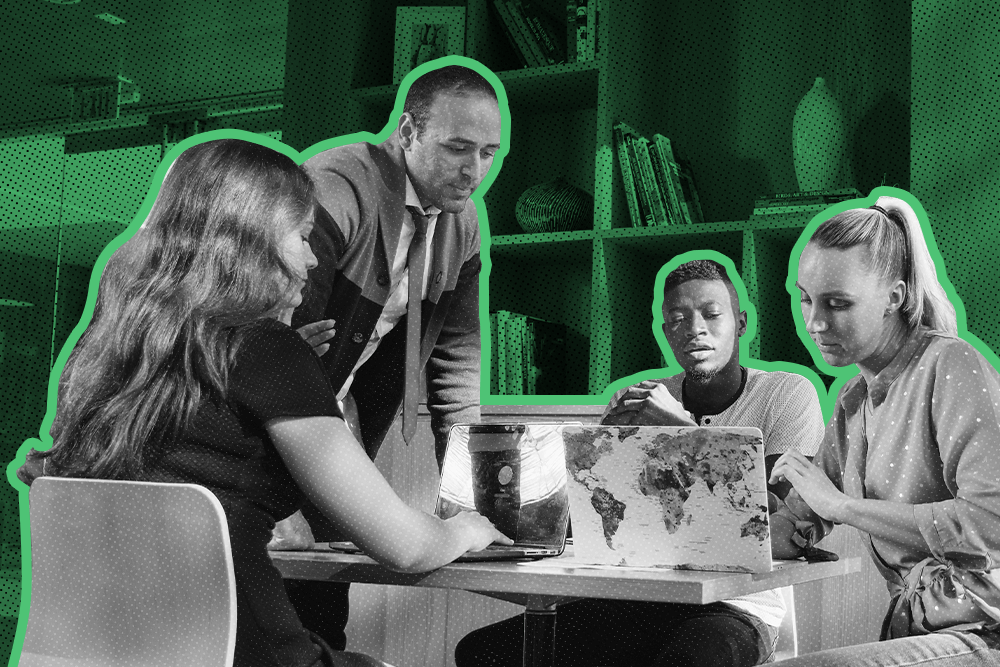
It feels like we’ve accelerated remote work by 10 years in the last 10 weeks. With over 1 billion search results for “work from home tips” on Google, it’s difficult to write something novel about remote work now.
That’s why, instead of trying to give you common tips, I’ll share my personal experience.
I transitioned to remote work 4 months ago, and I’ve had the opportunity to make plenty of mistakes (and learn from them). Here, I’d like to share those mistakes (plus the successes) with you and provide actionable tactics for your own WFH approach.
The mistakes I made early on
Working remotely can be very tricky to adapt to, especially in small, fast-paced teams. I was hired by Close at the end of December last year to head up Marketing Operations and Automation – I’m the guy who helps keep the MarTech engine running and finds new growth and efficiency opportunities.
I had worked remotely before, but never with a fully remote company. In advance of my start date, I spent quite a bit of time preparing and reading articles on remote work and ideal routines, and one of my favorite reads was Marcus Wermuth’s article on how to create a remote work routine that works. As you can imagine, I still made many mistakes early on.
Not being strict about designing my own day and when to put work down
I work earlier hours than most of my teammates. One of my colleagues is based out of Bangkok and is exactly 12 hours ahead of my time zone. When I’m starting my day, his day is ending. We also have a teammate based on the West coast, so she’s 3 hours behind me. Because of this, our team often has Slack conversations later in the evening (my time).
It’s easy to look at your phone and tell yourself you’re “...only going to answer this one quick message”. Sometimes it’s too easy.
Two things helped me draw a line between work and home:
1. A dedicated spot for work
2. A hard stop time
Have a dedicated spot for work
I love working from different environments: coworking spaces, coffee shops, my couch, my kitchen island, my backyard and my office. But I was curious to see if I could stop that behavior. Instead of moving around, I started limiting myself to only working in my office. This alone helped me feel less responsible for answering Slack messages when I wasn’t in my office. I wasn’t in “work mode”.
It got even better when I started leaving my laptop in the office and not bringing it with me on the couch at the end of the night. I haven’t started leaving my phone in the office yet though...baby steps.
Here’s what my home office looks like today.
- Plenty of natural light facing me so that everyone can see my face on video calls
- Extra selfie light and an HD wide lens webcam
- Noise cancellation headphones
- Wired ethernet connection
- A comfortable ergonomic chair
Have a hard stop time
At the end of each day, I spend 5 minutes planning tomorrow and looking at the schedule. Part of that is calendar blocking for specific tasks and projects that are the highest priority. But part of that is also deciding what time is my ‘stop time’. My working hours are usually from 7:30am - 3:30pm, so my stop time is usually around 4pm. But working remotely allows you to have flexibility on that stop time.
On Thursdays for example, my team preps our weekly Sales Brief newsletter that goes out to subscribers and customers every Friday. So most Thursdays I usually start working a bit later so that my stop time is around 6pm, allowing me time to work with the rest of my team on that initiative. Your routine will likely evolve over time depending on your schedule and when you’re most productive during the day.
Not understanding what times during the day I’m most productive
Building a routine when you’re working remotely is crucial. Everyone has different types of routines that are optimal depending on your personality, your lifestyle –and most importantly– the time of day you’re most productive.
I experimented with several different routines over the past 3 months. With all of these experiences, I maintained a few essential components:
- Get up, meditate, exercise, shower, eat
- Walk my dog and listen to a podcast
- Have lunch
- Reach out to teammates, plan tomorrow
The first routine I tried was designed to trick me into thinking I was productive in the morning.
- I would get through steps #1 and #2 above before starting my work day around 9am.
- I felt very energized in the morning...but I would have a big energy crash at the end of my work day.
So I switched up my morning routine to be just step #1 and leave #2 for the end of the day. I started seeing the walk + podcast as my reward at the end of the day and it worked well for being productive in the afternoon.
The next routine I tried didn’t last very long.
- I wanted to see if I could work 6 hours during the day, finish early, spend time with my fiancé, and then finish my work day when everyone in the house was asleep.
- Despite being very productive in those 2 night hours, my lack of sleep hindered my productivity the next morning.
The routine I settled on has been working well but has also been up for fine tuning in light of the pandemic.
- I still get through #1 first thing in the morning, I get up at 6:30am.
- By 7:30am, I’m in work mode in my home office and that’s my most productive time.
- I get a good 3 hours of focused work before most of my team is up. And since it’s not super late for my teammate in Thailand, I can use this time to go over some things with him.
- I break for a quick lunch around 12:30 and I leave my laptop in the office.
- After reaching out to a few teammates and planning tomorrow, I finish my day around 4:00pm.
- That’s when I grab my headphones, throw on a podcast and go for a walk with my dog.
Not being proactive enough about staying in touch with teammates
If you’ve recently started working remotely, one of the most important things is to proactively maintain social time. The non-work related Slack convos and banter are actually a core part of work. Especially now.
Instead of staying in touch with teammates during regular meetings or when you need their help, I try to make it a habit to check in with at least 1 person every day.
Over-communication is something I’m trying to be better at. The rule of thumb we have at Close is: whenever you’re wondering if you should say something, the answer is always yes.
At the end of every day I plan the next, but I also check in with a few teammates. Share some updates with your team:
- Good things that happened that day
- Any obstacles you’re facing
- What you plan on doing tomorrow
Depending on the day, you can find me at different spots on the extrovert–introvert spectrum. I love focused, quiet work. But I’m also very social. In-office work comes with a kind of natural camaraderie and banter that is hard to replicate in a remote team you’ve never met in-person before.
That’s why a lot of remote companies organize team retreats.
Our team retreat in Toronto
If you’re a remote team, retreats are your best opportunity to get aligned, set the course for the next six months, and strengthen your team culture.
In normal circumstances, twice a year, everyone at Close gets together for a week. It’s a big part of our remote team culture. If you want to learn more about how we run these team retreats, check out this post.
Here’s how Close promotes an engaged remote culture:
- Weekly 30-min company-wide video calls
- Weekly 15-min cross-functional 1-1-1 sessions
- Biannual week-long team retreats
- Everyone fills out a
Guide To Meon their work preferences
I had the opportunity of meeting my new marketing team in Toronto before the COVID-19 pandemic shut down most travel. We got together for a week to have a mini retreat... just the Marketing team.
The short time we spent together helped deepen the relationships within the team. We thickened our social fabric and got to know each other on a different level than just through video chat.
I work with a bunch of highly skilled individuals and we constantly push each other to learn and grow.
It’s hard enough to create a solid culture in-person and that’s likely even harder when everyone is scattered around the world.
What are the top three things that leaders can do to create a good remote culture?
My top benefit of working remotely: Adding 500 hours to my year
One of my favorite benefits of working remotely is shedding my commute. I save close to 2 hours per day by not having to bus to work. That’s an extra 500 hours or 12.5 weeks per year that I can spend doing other things. That’s the thing, what you do with that extra time is up to you.
Some folks will disagree with the commute benefit because they enjoy the downtime of driving to work and listening to a podcast, or taking the bus and reading a book. But I think that’s because they're spending that extra time working instead of doing the things they enjoyed doing while commuting.
There have been ups and downs, but I’ve adapted to a new mindful approach about spending some of that extra time learning instead of browsing Twitter or Reddit threads.
I’ve replaced my 2-hour daily commute with:
- 15 minutes of meditation in the morning
- 45-minute walks with my dog Eva while listening to a podcast, probably JRE or The Startup Chat
- 30 extra minutes with my fiancé, friends or family
- 30 intentional minutes of learning by reading before bed
The process I use for intentional learning
This is the process I settled on for limiting the amount of time I spend looking for content and deciding what to read:
- I’m subscribed to several email newsletters and Twitter feeds surrounding various topics. I use these as my top content curators. This content goes into an email folder and a Twitter list that I check once a week on Fridays. The articles that seem to be the most relevant are saved and tagged in Pocket.
- For 30 minutes, every night, I alternate between Pocket articles/podcasts, Blinkist and reading fantasy/fiction.
- For example, in December of last year when I wanted to prep for my interview with Close, I spent every night reading saved content in Pocket from Close or Steli.
- I’ve never been able to clear my Pocket. I have enough content in there to last me for almost 2 years.
- Before, I spent too much time browsing and curating and less time reading timely and relevant content. Now I have a time cap and a specific purpose in mind.
What’s next?
If you’re overwhelmed by the amount of remote work content out there and you’re looking for ways to adapt to this new normal, we've put together a microsite packed with helpful resources.
It’s worth signing up for our newsletter or at least saving a few of these articles in your Pocket for your intentional learning period tonight!










